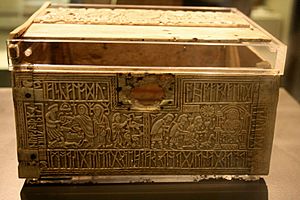Franks Casket facts for kids

The Franks Casket is a special small box made from whale bone. It was created in England around the early 700s. Today, you can see it at the British Museum in London.
This casket is covered with amazing carvings. These carvings show stories and pictures that are cut into the bone. It also has messages written in old Anglo-Saxon runes. Experts believe it was made in a part of England called Northumbria. The casket is super important because it helps us understand early Anglo-Saxon art and culture. People have spent a lot of time trying to figure out what all the pictures and runes mean.
The pictures on the casket are very different from each other. They include a Christian scene, showing the Adoration of the Magi (the wise men visiting baby Jesus). There are also scenes from Roman history, like Emperor Titus. And some pictures come from Roman mythology, such as Romulus and Remus, who founded Rome.
The casket also shows stories from old Germanic legends. One famous scene is about Weyland the Smith, a legendary craftsman. Some people think other scenes might show parts of the Sigurd legend or stories about Weyland's brother, Egil. There might even be a scene from a Greek story about Achilles. And perhaps a hint about the legendary founders of England, Hengist and Horsa.
The writing on the casket is very clever. Even though most of it is in Old English and runes, it switches to Latin and the Roman alphabet. Then it goes back to runes while still writing Latin words! Some of the writing is even upside down or backwards. The casket is named after Sir Augustus Wollaston Franks. He used to own it and later gave it to the British Museum.
The Casket's Journey Through Time
Most experts agree that the Franks Casket was probably made in a monastery. It might have been a gift for an important leader. Some think it was made at a place called Ripon. We didn't know much about the casket's journey after the Middle Ages until recently.
A researcher named W. H. J. Weale discovered that the casket once belonged to a church. This church was Saint-Julien, in Brioude, France. It's possible the casket was stolen during the French Revolution. After that, it ended up with a family in Auzon, a village in France.
The family used the casket as a sewing box! Eventually, they traded its silver hinges and fittings for a silver ring. Without these parts, the casket fell apart. The pieces were shown to a professor who sold them to an antique shop in Paris. In 1857, Sir Augustus Wollaston Franks bought them. He then gave the panels to the British Museum in 1867. He was in charge of the British and Medieval collections there.
The missing right side panel was later found by the family in Auzon. They had kept it in a drawer! It was sold to the Bargello Museum in Florence, Italy. In 1890, people realized it was part of the Franks Casket. Today, the British Museum shows a copy of this missing panel.
Secret Meanings in Runes and Numbers
Each Anglo-Saxon rune (an old letter) had a special name in Old English. This name gave the rune a hidden meaning. For example, the F-rune (ᚠ) was called feoh, which meant "wealth." The inscriptions on the Franks Casket are like poems. They use alliteration, which means words start with the same sound. This puts special emphasis on certain runes on each side of the casket.
According to one expert, Alfred Becker, these runes tell a story. The story matches the pictures. Each scene shows a different part of a warrior-king's life and afterlife.
- The front inscription highlights the F-rune (ᚠ, feoh for wealth) and the G-rune (ᚷ, gyfu for gift). This matches the jewelry made by Weyland and the gifts from the Three Magi. It suggests the casket held a warrior's treasures.
- The Romulus and Remus inscription emphasizes the R-rune (ᚱ, rad for journey). This reminds us how far the twins traveled. It also hints at the owner being called to battle.
- The side with Emperor Titus focuses on the T-rune (ᛏ, Tiw, the god of victory). This shows that a warrior's greatest achievement is winning battles.
- The right side first highlights the H-rune (ᚻ, hagal for misfortune). Then it uses the S-rune (ᛋ, sigel for sun or life). This part shows the hero's death and eventually, their salvation.
Becker also looked at the numbers of runes. He found that the front and left panels have 72 runes. The whole casket has 288 runes. These numbers are all multiples of 24. The number 24 was important because it's the number of runes in an older runic alphabet. The carver of the casket might have changed spellings to reach these special numbers.
Another expert, M. Osborn, agrees that the number 72 was used on purpose. But she thinks it has a Christian meaning. She believes the artist used these numbers to connect pagan ideas with Christian ones. The number 72 is important in the Christian Bible. In the Gospel of Luke, Jesus sends out 72 disciples to spread his message. This number was linked to missionaries going out to "all nations."
See also




